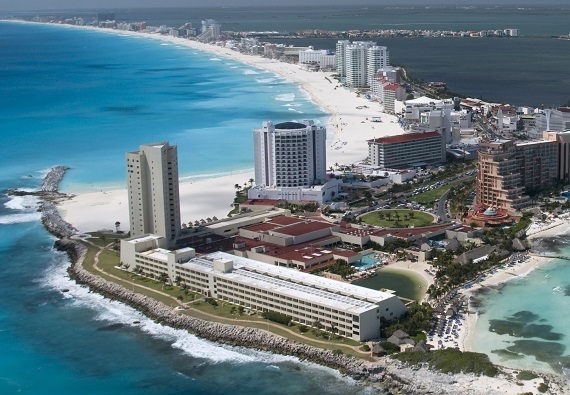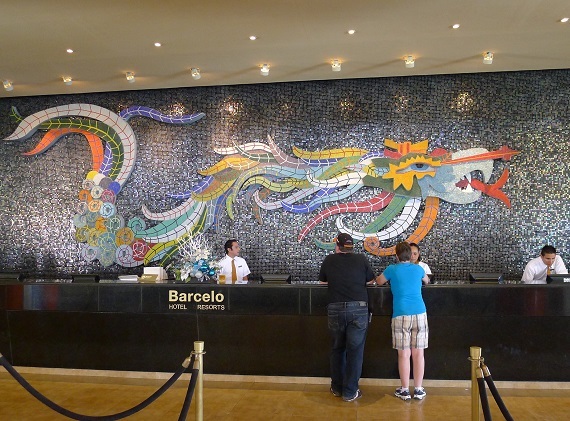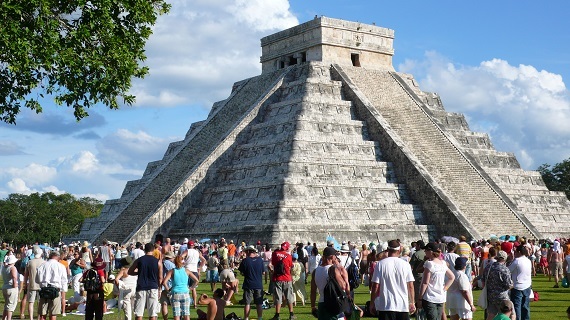The name "Kukulkan" pops up a lot around Mexico's super-resort at Cancun, the nearby Riviera Maya and the rest of what was once the Mayan empire, all the way down to Honduras. You see it on Cancun's main boulevard signs, on a magnificent pyramid in the inland ruins of Chichen Itza, on restaurants, bars and even grocery stores. Who (or what) was Kukulkan? The answer is simple (but probably not very helpful): Kukulkan is the Mayan version of Quetzalcuatl.
So who (or what) was Quetzalcuatl? One version of who he (or it) was comes from Hollywood. In the 1982 movie "Q: The Winged Serpent," he's an ancient Aztec flying snake god who somehow managed to build a nest in the art-deco spire of the Chrysler Building in New York. From there, he swooped down to the streets now and then to gobble up hapless New Yorkers -- until cops David Carradine, Richard Roundtree and a SWAT team gunned the beast down. The film grossed a whopping $255,000.)

Kukulkan Boulevard stretches the length of the Cancun resort area. Photo courtesy of the Mexico Tourism Board.
In Mexico, a popular legend of Quetzalcuatl (pronounced ketz-ahl-qwa-til) goes this way: Thousands of years ago, he was a god who took human form to become king of the Toltec empire in the central region of the country. Under his wings, the Toltecs became masters of the arts, farming, medicine, metallurgy and science. Their capital at Tula (about two hours north of Mexico City) was described by author Gary Jennings as "an immense city of golden turquoise-laden palaces, where meat, maize and honeyed sweets were plentiful as earth and air."
Among the largest and most elaborate pyramids in Tula was the five-tiered Temple of Quetzalcuatl. Unlike the scary beast portrayed in the "Q" movie, legends say he was a good god, beloved by his people. But he was too good (for instance, he hardly ever required human sacrifices), so his less liberal priests conspired to get rid of him. One day, they tricked him into doing something that today would be described as, er, inappropriate.
After that, he left town - perhaps around 1000 A.D. -- to ship out across the eastern sea to repent. Toltec legends say he told his people he'd eventually come back, and that he'd be on "a large raft manned by fair-skinned, bearded sailors."
A Layover in Chichen Itza?
Fast-forward a century or so. The Toltec empire has collapsed, but its culture has survived elsewhere in Mexico. Some 800 miles east of Tula, for example, a flying snake god-king named Kukulkan has ascended the throne of the Mayan empire at its sprawling city of Chichen Itza on the Yucatan Peninsula.
Could Quetzalcuatl have taken a side-trip on his way to the eastern sea to turn into Kukulkan? Did he spark the Mayan advances in the likes of art, science and astronomy over the years until the empire's collapse in the 1400s?
Meanwhile, back in central Mexico, the legend of Quetzalcuatl carried over to the Aztecs, the Toltecs' successors. For centuries, they awaited the fabled serpent's return from his atonement voyage on the big raft. (There was a false alarm in 1519, when Hernan Cortes and his 11 galleons manned by "fair-skinned, bearded sailors" came ashore at Veracruz on a date close to Quetzalcuatl's birthday - but that was to launch the conquest of Mexico.)
So was Quetzalquatl forgiven for his indiscretion? Or is he still at sea atoning for it? Other than having a bunch of things and places named after his Kukulkan (also spelled Kukulcan) personae, about the only thing anyone's heard about the Toltec god-king in the last half-century was his appearance in a forgettable movie.
But some cults among descendants of the Aztecs still await his return.

